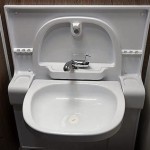How To Tell If My Bathroom Sink Is Porcelain Or Ceramic
Distinguishing between porcelain and ceramic bathroom sinks can be challenging, as both materials share a similar appearance and are widely used in bathroom fixtures. However, subtle differences in their composition, manufacturing process, durability, water absorption rate, and cost can help differentiate one from the other. Understanding these distinctions is useful for maintenance, repair, and replacement decisions, as well as for choosing appropriate cleaning products.
Both porcelain and ceramic sinks are made from clay-based materials that are fired at high temperatures, but the type of clay and the firing process contribute to their dissimilar attributes. Porcelain, generally, is considered a higher-end material due to its finer clay composition and denser structure. This article provides a detailed guide on how to identify whether a bathroom sink is made of porcelain or ceramic, considering various factors from visual inspection to specific tests.
Visual Inspection: Examining the Surface and Finish
The initial step in determining the material of a bathroom sink involves a thorough visual inspection. The surface of the sink can offer clues about its composition. Porcelain typically possesses a smoother, glossier finish compared to ceramic. This is a result of the finer clay particles and the vitrification process it undergoes during manufacturing. Vitrification refers to the process of heating a material to its melting point, resulting in a glass-like, non-porous surface.
Ceramic, on the other hand, might have a slightly more textured or matte finish. While some ceramic sinks are glazed to achieve a smooth appearance, they often lack the deep shine characteristic of porcelain. Look closely at the way light reflects off the surface. A porcelain sink will typically reflect light more uniformly, while a ceramic sink might exhibit more diffused or uneven reflection.
Pay attention to any imperfections or irregularities on the surface. While both materials can have minor flaws, ceramic is generally more prone to surface chips or cracks. This is because ceramic is often less dense and more porous than porcelain. Check for any visible pores or small holes on the surface, especially in areas that are frequently exposed to water. The presence of noticeable pores may suggest that the sink is made of ceramic.
Examine the edges and corners of the sink. Porcelain sinks often have sharper, more defined edges due to the finer clay and higher firing temperatures. Ceramic sinks might have slightly rounded or softer edges. The quality of the glaze application can also be an indicator. Porcelain glazes tend to be more uniformly applied and less prone to crazing (fine cracks in the glaze) compared to ceramic glazes.
It is also important to note that the color of the sink itself is not a reliable indicator of whether it is porcelain or ceramic. Both materials can be manufactured in a wide array of colors. The determining factor is the physical characteristics of the material itself, not its aesthetic appearance.
The Water Absorption Test: Porosity and Material Density
One of the most reliable methods for distinguishing between porcelain and ceramic is the water absorption test. This test leverages the difference in porosity between the two materials. Porcelain, being denser and more vitrified, has a significantly lower water absorption rate compared to ceramic. This means that porcelain sinks are less likely to absorb water, stains, or odors over time.
To conduct the water absorption test, the procedure must be carefully performed to yield accurate results. First, ensure the sink is completely dry. Weigh the sink carefully using a digital scale and record the initial weight. Then, thoroughly saturate the sink with water, making sure all surfaces are wet. Allow the sink to sit in water for a designated period of time, typically 24 hours.
After 24 hours, remove the sink from the water and carefully dry the surface with a soft cloth. Be sure to remove any excess water from crevices or hard-to-reach areas. Weigh the sink again using the same digital scale. Compare the final weight to the initial weight. The difference in weight represents the amount of water absorbed by the sink.
A porcelain sink will typically exhibit a very minimal weight gain, usually less than 0.5% of its original weight. This indicates its low water absorption rate. A ceramic sink, on the other hand, will likely show a more significant weight gain, often exceeding 0.5% and potentially reaching 3% or more. A higher weight gain signifies a higher water absorption rate, suggesting that the sink is made of ceramic.
The water absorption test is a destructive test in the sense that prolonged exposure to water can potentially damage the sink's finish or structural integrity, especially if it is made of ceramic and has existing cracks or chips. Therefore, it is recommended to perform this test in an inconspicuous area of the sink first, or only if you are prepared to potentially replace the sink if damage occurs.
The Sound Test: Tapping and Listening for Resonance
Another method for differentiating between porcelain and ceramic involves listening to the sound produced when the sink is gently tapped. This test exploits the differences in density and material composition between the two. Porcelain, being denser, typically produces a higher-pitched, clearer, and more resonant sound compared to ceramic. Ceramic, being less dense, tends to produce a duller, lower-pitched, and less resonant sound.
To perform the sound test, use your knuckle or a non-metallic object, such as a wooden utensil handle, to gently tap the surface of the sink. Tap different areas of the sink, including the basin, sides, and bottom. Listen carefully to the sound produced in each location. Pay attention to the pitch, tone, and duration of the sound.
A porcelain sink will generally produce a ringing or bell-like sound that sustains for a short period. The sound will be relatively high-pitched and clear. This indicates the material's density and ability to vibrate freely. A ceramic sink, on the other hand, will typically produce a thud or a muffled sound that dies out quickly. The sound will be lower-pitched and less resonant, suggesting that the material is less dense and absorbs vibrations more readily.
It is important to note that the sound test is subjective and can be influenced by factors such as the sink's shape, size, and mounting method. The surrounding environment and ambient noise can also affect the perceived sound. Therefore, it is recommended to perform the sound test in a quiet environment and compare the sound produced by different areas of the sink to get a more accurate assessment.
If possible, comparing the sound of your sink to that of a known porcelain or ceramic object can also be helpful. By tapping a porcelain plate or a ceramic tile, for example, one can familiarize themselves with the characteristic sounds of each material and more accurately assess the material of the sink.
Checking for Manufacturing Marks and Codes
Many manufacturers imprint marks or codes on their products for identification and tracking purposes. These marks can sometimes provide clues about the material composition of the sink. Look for any stamps, labels, or engravings on the underside of the sink or in areas that are not easily visible. These marks might indicate the material used in manufacturing.
The presence of specific codes or abbreviations, such as "porcelain" or "vitreous china" (a type of porcelain), clearly indicates the material used. However, not all manufacturers explicitly state the material type. Some might use more generic terms or model numbers that require further research. In such cases, searching the manufacturer's website or contacting their customer support can provide more detailed information about the product specifications, including the material composition.
It is also worth checking for certifications or compliance labels, such as those issued by ANSI (American National Standards Institute) or other relevant organizations. These certifications often specify the performance standards and material requirements that the product meets. Referring to the certification documentation can help determine whether the sink is made of porcelain or ceramic.
Even if a manufacturing mark is present, it is necessary to verify the information with other methods, such as the visual inspection, water absorption test, or sound test, to ensure accuracy. Manufacturing marks can sometimes be misleading or incomplete, and relying solely on them might lead to an incorrect conclusion.
How To Tell If My Bathroom Sink Is Porcelain Or Ceramic Quora

How Can I Tell What My Bathroom Sink Is Made Of
How To Tell If My Bathroom Sink Is Porcelain Or Ceramic Quora
How To Tell If My Bathroom Sink Is Porcelain Or Ceramic Quora

Ceramic Porcelain Sink Repair True Value

How To Remove Stains From A Porcelain Sink Isavea2z Com

Porcelain Vs Ceramic Sink Which One Is Better My Interior Palace

How To Tell If My Bathroom Sink Is Porcelain Or Ceramic Quora

How To Care For Porcelain Fixtures
:fill(white)/www.toppstiles.co.uk/static/uploads/2020/10/Inara-Cloud-30x60-Inara-Coal-60x60_V1.jpg?strip=all)
Porcelain Vs Ceramic Tiles Topps







